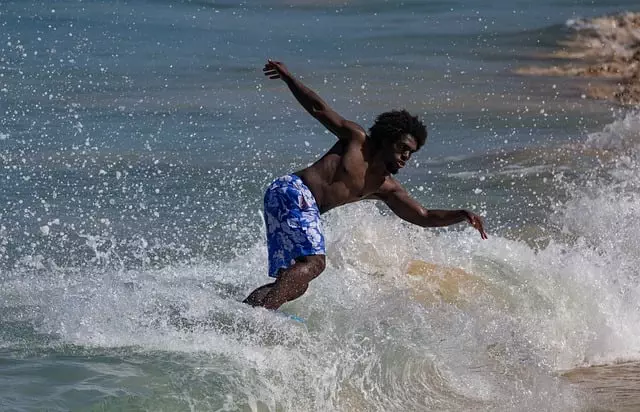For beginners venturing into surfing, a surfboard specifically designed for novices is essential for a positive and productive start. Such boards should offer stability, buoyancy, and maneuverability to accommodate the learning curve associated with wave riding. A surfboard for beginners typically measures between 7 to 9 feet to provide ease of paddling and enhanced floatation. Soft tops with longboard characteristics or Mini-Malibu models are ideal due to their forgiving nature and easy handling, which reduce the risk of injury during falls. These boards also come in a variety of thicknesses and volumes, with thicker options offering increased buoyancy for those still mastering the basics. The hull shape, including a wider deck outline and rounded pin tail, contributes to stability, making it easier to maintain balance and control while catching and riding waves. Beginners should opt for boards with smaller, softer fins to ensure safety and a smoother learning experience. Choosing the right surfboard for beginners sets the foundation for a lifelong passion for the sport and can make all the difference in enjoying the journey of learning to surf.
Exploring the world of surfing can be exhilarating, yet daunting for beginners. Selecting the right surfboard is pivotal to a smooth learning curve and enjoyable experience. This article demystifies the range of sizes available in surfboards tailored for novices. We’ll delve into the basics of surfboard lengths, the importance of volume for buoyancy, and the impact of thickness and board design on stability and comfort. Additionally, we’ll guide you through understanding fin configurations to enhance your initial rides. By the end, you’ll be equipped with knowledge to choose top-recommended models of surfboards for beginners that align with both size and performance needs.
Understanding the Surfboard Size Spectrum for Beginners

Choosing the right surfboard is a critical step for beginners looking to navigate their first waves with confidence and ease. The spectrum of available surfboards ranges from longboards, which offer greater stability and are more forgiving on smaller waves, to shortboards designed for quick maneuvers in larger swells. For novices, the most suitable options often fall within the “minimal” or softboard categories due to their user-friendly design and paddle ability. These boards provide a balance between stability and responsiveness, allowing beginners to catch waves without overwhelming them with technical demands. It’s essential for beginners to select a board that aligns with their body size and the types of waves they’ll encounter. As a rule of thumb, longer boards tend to float better and are more buoyant, making them an excellent choice for those who weigh less or are lighter in stature. Additionally, wider boards offer increased stability, which can be particularly beneficial for beginners as they gain proficiency and confidence. Understanding the various dimensions and shapes available will empower new surfers to make informed decisions that contribute to a more enjoyable and successful experience on the water.
The Basics of Surfboard Lengths and Their Suitability for Novices

When selecting a surfboard for beginners, understanding the basics of surfboard lengths is crucial. Surfboards come in a variety of sizes, and the appropriate choice can significantly influence a novice’s learning curve and overall enjoyment of the sport. Typically, longer boards are more forgiving and offer greater stability, making them ideal for those just starting out. A beginner’s surfboard generally ranges from 7 to 9 feet in length. This size allows for easier paddling due to a larger surface area, which is essential for catching waves. Additionally, the increased buoyancy helps in maintaining balance and control while standing up on the board. For beginners, a soft top surfboard with a longboard shape is often recommended, as it provides a gentler ride and is less likely to cause injury should a wipeout occur. As skill levels progress, surfers may opt for shorter boards that offer more maneuverability, but for the initial stages of learning, sticking to a longer, more stable surfboard for beginners is advisable. It’s also important to consider the board’s thickness and volume, as these factors contribute to buoyancy and how the board performs in different conditions. A well-chosen beginner’s surfboard can make the difference between a frustrating experience and the joy of riding waves with confidence.
Volume Matters: Why It's Key for Beginner Surfers

Choosing the right surfboard is pivotal for beginner surfers as it directly influences their progression and enjoyment in the sport. A surfboard for beginners should offer a balance of stability, buoyancy, and maneuverability to accommodate the learning curve that comes with mastering the waves. Volume within the board plays a crucial role in these aspects. Higher volume means more floatation, which is essential for novices who are not yet comfortable with paddling into waves or standing up on their boards. This additional buoyancy helps prevent the board from sinking when the surfer is lying down to paddle and provides a more forgiving platform when attempting to stand, reducing the likelihood of falls and the associated frustration. Moreover, a well-volume surfboard for beginners can offer a smoother ride, allowing the surfer to experience the joy of gliding on the water with greater confidence. As they progress, beginner surfers can gradually transition to boards with less volume, which are typically more responsive and maneuverable but require a higher skill level to control effectively. Therefore, when selecting a surfboard for beginners, considering the volume is key to ensuring a safe, enjoyable, and productive learning experience on the water.
Thickness and Buoyancy: A Beginner's Guide to Board Design

When selecting a surfboard for beginners, understanding the relationship between thickness and buoyancy is crucial for a safe and enjoyable experience on the water. Thickness is not merely an indicator of how much foam is used in the board’s core; it significantly affects your ability to float. A thicker board provides greater buoyancy, which means beginners can easily paddle onto waves without requiring exceptional strength or technique. This aspect is particularly important for those who are still developing their surfing skills and may not be confident in their ability to stay afloat. Boards designed with a beginner’s needs in mind typically range from 2.8 inches to 3.5 inches in thickness, offering a balance between buoyancy and maneuverability.
In addition to thickness, the volume of water that a surfboard displaces also contributes to its buoyancy. For beginners, a board with a higher volume will be more forgiving, making it easier to catch waves and maintain stability while standing up. The shape of the hull, or the outline of the deck, is another factor that can influence both performance and ease of use for new surfers. A wider shape provides a broader platform for beginners to paddle from, enhancing their chances of successfully riding a wave. When choosing a surfboard for beginners, consider models with a rounded pin tail, which offers more stability and makes it easier to control the board through a turn or along the wave face. These features combined in a beginner’s surfboard can make the difference between a rewarding experience and one that might deter you from pursuing this exciting sport further.
Choosing the Right Width for Stability and Comfort in Your First Board

When selecting your first surfboard, prioritizing stability and comfort is crucial to ensure a positive experience on the waves. For beginners, the width of the surfboard plays a significant role in providing the necessary support as they learn to navigate the ocean. A wider board, particularly between 23 to 25 inches in thickness, offers more buoyancy, which is essential for novices who may not yet have the confidence or skill to maintain balance on narrower boards. This added buoyancy helps prevent the board from shooting out from under you when paddling into a wave. In terms of length, a longer board can also contribute to stability, as it provides more surface area to hold your weight and glide smoothly across the water. For those who feel apprehensive about standing up on a surfboard for the first time, opting for a longer board within the 7 to 9-foot range can be advantageous. These boards are designed with a beginner’s experience in mind, offering a gentle learning curve and the confidence needed to explore the world of surfing without the anxiety of losing balance. When choosing your surfboard for beginners, consider how it feels when you carry it under your arm: it should seem manageable and not overly cumbersome. In the water, it should support you effortlessly, allowing you to focus on mastering the basics of surfing rather than battling with your equipment.
Fin Configuration and Its Impact on a Beginner's Surfing Experience

Choosing the right surfboard is paramount for beginners looking to embark on their surfing journey with confidence and ease. Fin configuration plays a significant role in how a beginner will navigate and control the waves. Typically, a softboard designed for novices will have smaller, softer fins that are less prone to causing injury should a wipeout occur. These fins offer reduced resistance, which helps beginners paddle into waves with less effort. Furthermore, the fin setup influences the board’s maneuverability and stability. A three-fin setup, often referred to as a thruster, provides a balance between responsiveness when turning and the ability to maintain speed and directional stability. This is particularly beneficial for beginners who are still developing their surfing skills and need a board that can help them through the learning curve. As they progress, the feedback from these initial experiences with different fin configurations will inform their preferences for more advanced boards, ensuring a smoother transition as their proficiency advances. Selecting a surfboard for beginners with an optimal fin configuration not only enhances the initial learning experience but also contributes to a safer and more enjoyable introduction to the sport of surfing.
Top Picks: Recommended Models of Surfboards for Beginners Based on Size and Performance

For those new to the world of surfing, selecting the right surfboard is paramount for a positive learning experience. A beginner-friendly surfboard should offer stability, buoyancy, and be forgiving of beginners’ mistakes. Among the top picks for beginners, the Softop Longboard stands out due to its length, which provides glide and easy paddling, making it ideal for catching waves with ease. Its wider outline and rounded rails enhance stability, reducing the likelihood of falling off unexpectedly. Another excellent option is the Mini-Malibu model, which combines maneuverability with a forgiving design. Its slightly smaller size compared to a traditional longboard allows for more dynamic turns without compromising on the board’s floatation and ease of use. Both models are designed to accommodate different preferences in terms of size and performance, catering to a range of surf conditions and personal riding styles. Whether you’re looking to ride small, waist-high waves or larger, chest-high ones, these surfboards for beginners offer the versatility and ease needed to progress comfortably. When choosing between these models, consider your height, weight, and the types of waves you’ll most often encounter to ensure the best match for your surfing journey.
